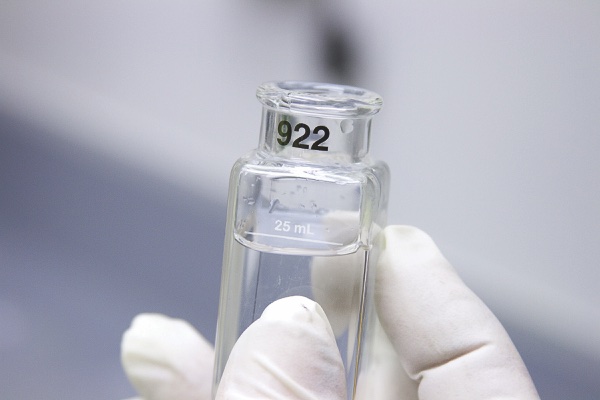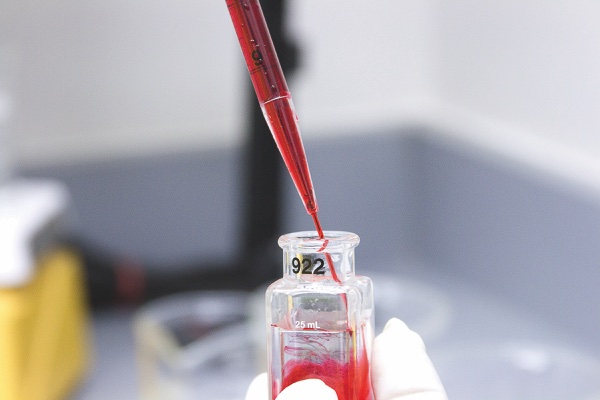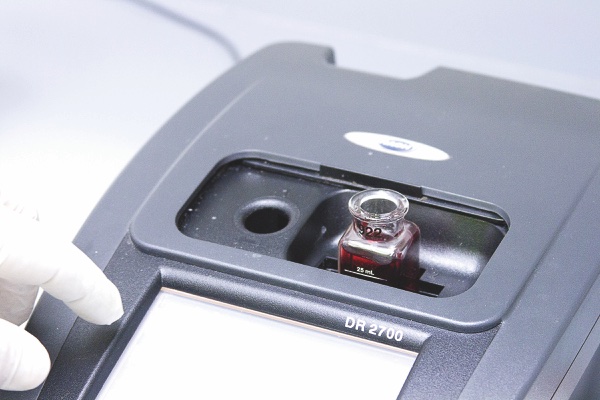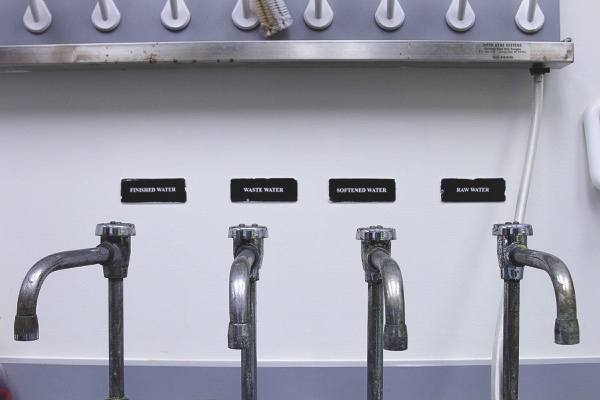“Three hundred miles from Flint, how safe is your water?” read the headline in an April 2016 Huntley-area newspaper.
It was an understandable and often-asked question throughout the nation after the water supply in Flint, Michigan, was discovered to be contaminated. The problem there got so serious that some former city officials are now being prosecuted.

Huntley Water Treatment Operator Jeff Mohr tests a sample of drinking water for impurities at the well 9 laboratory near Kreutzer and Main. (Photos by Chris LaPelusa/Sun Day)
Sun City receives its household water from the Village of Huntley’s system of five deep wells (1,500 feet down) and four water treatment plants. The Sun Day recently talked with Village Engineer Tim Farrell, and Water and Sewer Superintendent Steve Zonta.
The two provided a reassuring message for Sun Citians regarding Huntley’s water safety and quality, and some background on how and why that situation has been achieved.
First of all, they said the Flint water system was constructed a long time before the nation’s water quality laws and standards were tightened and upgraded in the 1980s and 1990s. It is lead-based.
“The core problem in Flint is the presence of lead in residence water supply lines,” Farrell said. “These pipes carry water from water mains to residents’ homes. Sun City was built in the late 1990s and the early part of the next decade. By that time, the standard for municipal water systems had changed to copper, so there is no chance that lead poisoning in water can happen were there are no lead pipes.”
“Also, we have dug deep wells here, as many communities do, to minimize the presence of contaminant that we have to deal with. Deep well water does have naturally occurring radium, so we treat and test our water very frequently to reduce the level of radium well below standards set by federal and state authorities. Our water contains far below the maximum amount of iron as well.”



Quality tests are preformed at each well 365 days per year.
Farrell also acknowledged that, in 2008, Huntley was one of more than 300 Illinois communities whose levels of radium in the water exceeded state Environmental Protection Agency standards that were tightened in 2001.
“We were in compliance according to the previous standards, but then the IEPA changed them, and many communities suddenly had to upgrade their safety and quality levels,” Farrell said. “We were maximizing all of our water treatment protocols, and our radium levels went above the new limits in 2008. We were placed on a quarterly testing schedule instead of annual by the IEPA, and we made adjustments to get into compliance. We have demonstrated compliance since that time. The violation occurred in only one of our five wells. Because radium is a chronic pollutant, and the village failed only one sample, Huntley’s water was never unsafe during that period,” he added.
Zonta, who coordinates the day-to-day water quality and treatment activities in Huntley, said, “Water quality is a daily activity in our public works department. We do our own testing daily, in addition to testing monthly and quarterly as required by state and federal regulations. We test our water that is in the distribution system, as well as water that is in our wells. Testing and quality control are a daily party of the management of our water system.”
Huntley, like most of its neighboring communities, does not receive Lake Michigan water, as Chicago and many communities to the east do through a system of mains and pipelines extending from Chicago’s lakefront.
“As part of completing our master utility plan, we took into consideration the possibility of receiving Lake Michigan water and gain all of the benefits of the treatment that Chicago provides.” Farrell said. “But the closest any of the safe water pipelines come to us is in Hoffman Estates. It is prohibitively expensive to pipe the water into Huntley, not to mention all of the political challenges of joining with our neighboring towns to make it happen. The modest saving in treatment would be far more offset by the expensive construction of a distribution system from Hoffman Estates.”

Zonta said the village’s water is tested at the McHenry Analytical Water Laboratory, as it is for many other communities in the northwest Chicago suburban area.
The two also said Huntley residents have the option of getting their own water tested at the McHenry facility. The cost, according to one recent media report, is under $100. A McHenry spokesperson was quoted as recommending that residents use the water facility’s equipment and receive instructions on how to use it, before collecting the samples.
Water filtration systems are available at retail outlets that reportedly cost anywhere from less than $100 to several hundred dollars, depending on how sophisticated the equipment is. Organizations like the Water Quality Association and the Environmental Working Group, provide information on filtration systems on their respective websites, wqa.org and ewg.org, according to the media report.




